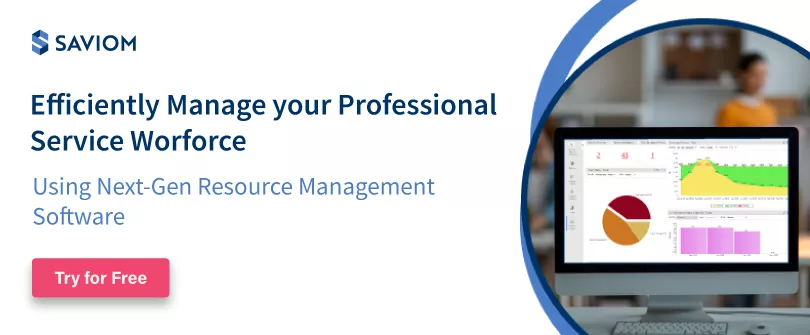The technology-tycoon Bill Gates has once said, ‘IT and business are becoming inextricably interwoven. I don’t think one can talk meaningfully about one without talking about the other.’
The business industry has seen a massive transformation in terms of work culture, management practices, skill requirements, and so on over the past decade. Technology is the major propeller behind these reinventions. It has empowered and enabled businesses to expand their horizons.
For example, telepresence has facilitated employers to recruit from beyond geographical peripheries. The second major example is Automation. It has eliminated the need to spend countless hours on mundane admin work. Employees can now focus and spend time on human-specific business work that demands critical thinking. The list of these instances is endless.
One of the major industries that have seen a paradigm shift is the Professional Services Industry.
With ever-evolving market trends, there is a radical shift in customer demands, business models, and the way services are delivered to the clients.
It’s time for decision-makers to accept and adopt these trends to stay relevant in the long haul.

This blog highlights 5 major professional services trends that are disrupting the industry. Before we dive deep into it, let’s get the basics right.
What are professional services?
Professional services encompass a plethora of occupations that extend support to businesses in the form of consulting, advice, or by performing other tertiary roles.
Some of the key services include:
- Law- Providing legal assistance to the firms to ensure they adhere to the current laws and regulations.
- Audit & Accounting– Reviewing and assessing financial accounts to ascertain the legality of their financial records.
- Consulting- Working coherently with the organization to help them maximize their operational efficiency
- Financial advisory- Helping the decision-makers to make sound investments and secure their finances
- Actuarial Science- Predicting and evaluating future financial risks using statistical models
The reason behind taking external help from these services is their professional expertise, business acumen, and years of experience. Thus, to keep serving the organizations to the best of their abilities, every professional services firm has to keep up with the trends and adopt a core strategy that aligns with the ever-evolving market.
Read More: What is Workforce Planning, and How to Master it for Business Efficiency?
Let us see how
Re-evaluate the core strategy to align with the new norms
The two paramount characteristics that set the professional service firm apart from other business are:
- The bespoke service they offer to every client regardless of the tools and models used.
- The underlying nature of cultivating and fostering long-lasting client relationships.
In order to maintain the competitive edge, it’s imperative to walk along with the new norms that are redefining your industry. For instance, you cannot compete in a technology-driven market with silos of data and legacy tools. You need to equip the advanced and robust software to provide automated delivery and more-accurate insights to the clients.
The new norms that are driven by technology and other factors demand a more agile, value-driven, and tech-enabled firm. Thus one has to focus on the proactive and targeted transformation of their core strategy to increase sustainability.
These innovative trends that are compelling you to redefine your strategy can be categorized into two sections:
- Business-centric
- The emergence of Automation and Artificial Intelligence
- Increase in globalization and virtual offices
- A value-driven revenue model
- Employee-centric
- Recruitment of hybrid talent to fill the skill gaps
- A tech-enabled work-culture to enhance team engagement
Here is a description of each one of these in detail:
The trends that will transform the PS industry
- Business-centric trends
Emergence of Automation and Artificial Intelligence
In order to provide the most appropriate business solutions to clients, professional services demand extensive data-analysis. This process is time-consuming and prone to human errors.
The onset of Artificial Intelligence and Machine Learning has made this tedious process simpler. It essentially interprets the real-time data and organizes large chunks of data into usable information. Resources also can learn from the past data and generate strong, data-driven insights for the clients. This systematic arrangement of data helps them make sense out of complexities conveniently.
Technological advancement does not limit here. Organizations are now gearing-up to automate the mundane back-end tasks that limit the employees from doing valuable work. This enhances task efficiency and enables resources to focus on activities that are role-specific and polish their skillset and capabilities.
Emerging technologies such as RPA (Robotic Process Automation), Chatbots, IoT (Internet of Things), Block-Chain, and CNN (Convolutional Neural Networks) are creating a new business model for traditional businesses.
According to a report by Mckinsey, a leading bank automated about 900 of its back-end operations to relieve 50% of its full-time employees from their admin tasks. Some of these employees were successfully deployed in other meaningful activities within the bank to increase overall productivity.
Read More: Project Resource Management: An Ultimate Guide on How to Master it
Increase in globalization and virtual offices
Gone are the days when recruitment was restricted to specific locations due to communication, collaboration, and performance tracking barriers. A myriad of collaboration and video-conferencing tools are available today to make information-sharing a breeze.
Moreover, intuitive project and resource management tools have allowed managers to keep a track of their projects and resources’ performance from across geographical boundaries. Due to these provisions, clients are approaching the firms based on their reputation and work regardless of where they are located.
In addition to getting global clients, firms are recruiting valued talent with niche skills from across the globe. This is because virtual offices and remote work have become an integral part of the work culture and environment. Moreover, the COVID-19 pandemic has escalated the emergence of virtual offices.
In fact, a recent study from Gartner reveals that 82% of Company Leaders Plan to allow employees to work remotely.
In short, the skills scarcity and unavoidable circumstances have led to an increase in globalization and remote workspace.
Read More: Top Ten Business Benefits of Resource Management
A value-driven revenue model
Professional services like Audit & Accounting charge the client on an hourly basis. This billing model does not consider the value generated out of each task. For example, an hour of billable work is leading to 10% of tax savings for the client. However, you are still invoicing the client based on the employee’s charge out rate rather than on the task’s value.
This reduces the profit margins for professional services firms and the clients fail to see the benefits of the overall project. To change this, firms are now opting for a value-driven revenue model that will bill the client based on the benefits and profits they make during the course of the project.
A client will now pay for the overall gains such as tax savings, ROIs, insurance claims, and so on. This shift from time-driven to the value-driven model allows PS firms to get more clients and increase their profitability.
Read More: What are Billable Hours & its Importance in Consulting?
These are some of the business-centric trends that are disrupting the PS realm. Let us now see the trends that are transforming the workplace culture,
Employee-centric PS trends:
Recruitment of hybrid talent to fill the skill gaps
Often the firms end up hiring permanent employees for one-time project tasks. This results in unnecessary administrative overhead costs. Unplanned or inappropriate hiring happens due to inefficiency in pipeline management and capacity planning. Now that organizations have the liberty to digitize their resource and project management platforms, they are going for a hybrid-talent model.
Hybrid talent refers to creating the right resource mix i.e. a team of full-time employees, contractors, freelancers, and so on. It also includes creating a team based on the band-levels, resource costs (local and global resources) to control the project financials.
Professional services firms are now adopting advanced tools that predict the resource demand in advance and allow them to draw out a hiring plan. This greatly reduces the project resourcing costs and increases their profitability.
Furthermore, these tools provide real-time visibility of resource schedules and their utilization levels. Managers can leverage this and optimize resource allocation thereby preventing employee burnout.
A tech-enabled work-culture to enhance team engagement
Team engagement is critical to driving business to success. According to Forbes, highly engaged teams show 21% greater profitability. Encouraging team engagement is easy when you are working in co-located offices. However, it becomes a challenge when your team is distributed across different locations.
With the advent of highly-advanced collaboration tools and companies investing to foster a tech-enabled work culture, employees can communicate and share important information in real-time. This enhances team engagement and allows quick problem-solving.
Moreover, when teams are connected, their productivity increases and gives better results. Professional services firms are therefore indulging in building a tech-enabled work environment that will strengthen their employee’s morale and improve performance.
Read More: 11 Ways to Improve Cross-Departmental Collaboration
Conclusion- The future of Professional Services
The growing trends and technology have provided a historic opportunity for the professional services industry to pivot and change the nature of business.
If the firms adapt to these evolutions, how will the future face of PS look like?
The project-delivery will be more efficient, accurate, and data-driven. The client-engagement will grow leaps and bounds in the presence of advanced collaboration tools. The ease of sharing real-time data will escalate and simplify performance tracking.
Business Intelligence will provide comprehensive reports on varied project metrics that will allow you to predict and plan in advance. In addition to this, automation will improve the productive utilization of resources to a great extent.
Overall, the ever-evolving trends will disrupt and change the face of the professional services industry.
Are you ready to evolve and grow along with them?
The SAVIOM Solution
SAVIOM is no doubt the market leader in offering the most powerful and configurable Enterprise Resource Management Solution. Having more than 20 years of experience, this Australian-based MNC has a global presence in over 50 countries. It is also popular with more than 100 customers and helping them to achieve their business goals. SAVIOM also has products for project portfolio management, professional service automation, and workforce planning software which can be easily customized as per business requirements.












